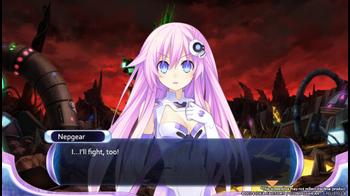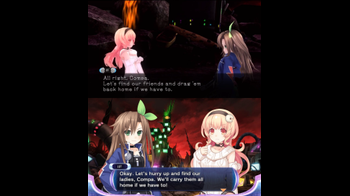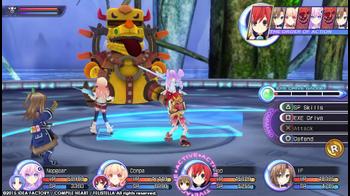
Hyperdimension Neptunia Re;Birth 2: Sisters Generation Review
As someone who has long been fond of the Hyperdimension Neptunia series, Neptunia mk2 represents a case study of what happens when a developer tries a little too hard to experiment with what is already a good thing. Not only did they throw out most of the main cast in favor of a new set of “little sister” characters who were retconned into the story in a none-too-subtle fashion, but they also played around with different game systems and changed the entire look of the story’s presentation.
It threw people for a loop and it was obvious that Compile Heart understood that when Neptunia Victory came out afterwards. With Hyperdimension Neptunia Re;Birth 2: Sisters Generation, some very important changes have been made to incorporate the best features of the series, bringing the vital changes the game really needed in the eyes of fans, although I wish the same could be said about the writing.
The world of Gameindustri is made up of four nations that inhabit separate continents: Planeptune, Lowee, Lastation, and Leanbox, whom each are represented by the CPU Goddesses Neptune, Blanc, Noire, and Vert, respectively.
In order to stomp out the growing threat of the evil organization known as ASIC whose very existence is to revive the Deity of Sin, Arfoire, the group along with CPU Candidate Nepgear travels to the Gameindustri Graveyard to defeat them once and for all, but suddenly find themselves on the losing side and wind up being captured.
After three years of being held prisoner, their friends IF and Compa show up in an attempt to rescue all five of them, but are only able to free Nepgear from her bonds before being forced to escape. Upon their return, Nepgear vows to free her sister and her friends from the clutches of ASIC, and enlists the help of the other CPU Candidates along with some very capable allies to help bring them home.
I’ll be upfront in saying that a lot of this article is going to read similarly to my review for Hyperdimension Neptunia Re;Birth 1 at least when it comes to game mechanics, because a lot of it is indeed the same. This is especially true when it comes to the battle system that takes the best parts from Neptunia Victory, specifically the customizable Rush, Power and Break attacks. These moves are unlocked as characters level up to become more destructive and can take after different magical elements like fire, ice, and lightning.
The EXE Gauge also makes a welcome return in order to deal a huge amount of damage once the bar is filled, helping to take chunks of health off even the toughest of bosses. There seems to be a larger number of skills and EXE Gauge attacks compared to the first.
Another change is that having the CPU Candidates switch to their HDD form no longer depleted SP over time, instead making it a one-time consumption upon activation, making it a far easier choice to make on whether to transform.
The difficulty certainly scales a lot better here than in Re;Birth 1 - there weren’t any sudden spikes to speak of, but rather a gradual curve over the course of the story. Instead of having to spend large portions of time grinding my characters up, I was able to make my way through Neptunia Re;Birth 2 relatively easily with only a few stops along the way. Just comparing the two titles, I was able to beat the sequel with a party 20 levels lower than Re;Birth 1.
One of the biggest knocks against Hyperdimension Neptunia mk2 was its use of 3D models during the dialogue between characters that felt a little jarring after coming off the 2D animated portraits. A big draw for fans of the series was seeing Tsunako’s art in motion (limited as it may have been). While it did feel like the developers invested more into the game's budget, it just came off looking pretty drab in comparison to other games at the time.
Thankfully, with this edition of the game, the original 2D portraits are back and in tip-top shape - the art looks sharp on the smaller screen, and really emphasizes how well these games look and feel when they’re not blown up to a 60-inch screen where every little detail can be scrutinized. The game also runs a lot smoother than it used to and the character models are much more meticulous.There is also a redone Prologue, replacing the original's confusing and a little too melodramatic tone.
The writing leaves something to be desired and doesn’t hold up to the same quality as the first one did, with the jokes that hit being few and far between. Without the original four CPU Goddesses, things just seem to drag, so much so that it even became a running gag in Neptunia Victory how people just didn’t take to Nepgear as a main character.
Mind you, I don’t have any real problems with Nepgear, Noire, Ram, or Rom, but the writing does come across as pretty flat for the most part and it’s missing a lot of the hilarious fourth-wall-breaking humor found in the original Hyperdimension Neptunia.
A huge casualty here is the rest of the party: gone is one of my favorite characters in Nisa (RIP, Keeper of Justice) along with Gust, and in their place are the Oracles of the four continents who can be recruited for the first time. Red and Broccoli also make their return as party members. You can also recruit CyberConnect2, Tekken-chan, and MarvelousAQL who all make a return from Re;Birth 1, along with former DLC characters Cave and Falcom.
Hyperdimension Neptunia Re;Birth 2 follows the exact same template that Re;Birth 1, down to the design layout, similar-looking menus, and overworld navigation. The Remake System, the feature that lets you unlock items, add dungeons, and manipulate the code of the game, hasn’t changed at all, although they have added a few new options like being able to defeat weaker enemies on the field simply by using the Symbol Attack (swing your weapon with the X button).
One of my favorite new features is Stella’s Dungeon, a fun little mini-game where a young girl named Stella can be told to scavenge the different dungeons in the game to hopefully bring back rare items for you and new equipment for her to use in order to survive the journey.
In true style similar to a roguelike, if Stella happens to get knocked out during this, she will lose any items she had obtained along with the equipment that she happened to be wearing. While this may sound a little tedious, this adventures can last anywhere from 10 minutes to a couple hours and runs off of the handheld’s real-world clock. It’s a pretty neat feature and one that I hope make an appearance in future games.
The developers also added a new ending to the game that seems to take the place of a certain highly controversial one from mk2 that has still has me waking up with a cold sweat to this day.
Other than that, everything else is practically identical to the PlayStation 3 version including the dungeons that lack in terms of variety much like the rest of the series.
However, thanks to the solid additions that the new version has brought to the game including the Remake System, a return to 2D portraits, and Victory’s battle system, this is clearly the best way to experience Hyperdimension Neptunia mk2 thanks to those important gameplay changes.


